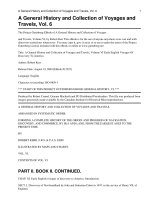Vol 6 cfd trading guide
Bạn đang xem bản rút gọn của tài liệu. Xem và tải ngay bản đầy đủ của tài liệu tại đây (354.95 KB, 19 trang )
CFD TRADING GUIDE
Editor Matthew Carstens
WWW.INVESTING.COM
FOREX TRADING GUIDE
1
INDEX
The aim of this guide is to provide you with prerequisite information that you will
need before venturing into CFD trading. This guide is not intended to encourage
nor discourage you about CFD trading. Any investment decision you make should
only be done after you have consulted your broker or financial advisor with respect
to your financial circumstances.
1. Brief History of CFD’s............................................................................................... 3
2. What are CFD’s?...................................................................................................... 4
3. Notable CFD Terms.................................................................................................. 5
4. Available CFD’s........................................................................................................ 7
5. Trading CFD’s......................................................................................................... 10
6. Pros & Cons........................................................................................................... 11
Pros............................................................................................................................ 11
Cons........................................................................................................................... 12
7. 5 Trading Tips........................................................................................................ 13
8. Choosing a Broker................................................................................................. 15
9. Trading Risks......................................................................................................... 18
2
CFD BEGINNERS GUIDE
CFD BEGINNERS GUIDE
Brief History of CFD’s
Brief History of CFD’s
The first CFD was created in the 1990’s by a derivative brokerage firm called Smith New
Court in London in order to fulfill the needs of hedge funds who wanted to short the
market using high leverage in order to place larger bets.
CFD’s also gave these hedge funds the ability to avoid stamp duty (because there are
no actual shares being bought) which quickly gained them further attention, though are
still subject to Capital Gains Tax charged on the income earned from closed contracts.
The first company that brought CFD’s to retail investors on a mass scale was GNI. They
did this through their online trading system called GNI Touch. Through GNI Touch private
investors and small investment companies were actually able to trade assets on the
London Stock Exchange as a CFD.
At this time, volatility was the norm for just about any tech stock which was a perfect
environment for CFD trading as the daily pendulum changes in these tech stocks made
long term investments unnecessary. Once traders understood the advantages of CFD
trading over the more conventional share trading, the CFD offering expanded into other
asset classes like indices, commodities and currencies. At present about 25% of Britain
stock market trading volume is related to CFD’s trading.
CFD BEGINNERS GUIDE
CFD BEGINNERS GUIDE
3
What are CFD’s?
What are CFD’s?
The Acronym CFD stands for contract for Difference. it is an agreement to exchange
the difference of price movements in a financial market or instrument.
The trader does not actually own shares of a company, or asset, rather just has the right
to buy or sell an amount of shares or contracts on margin which results in a profit or loss
to the trader. Simply put, CFD’s are just another trading vehicle for you to speculate with
whose price is derived from an underlying, exchange traded, market.
4
CFD BEGINNERS GUIDE
CFD BEGINNERS GUIDE
Notable CFD Terms
Notable CFD Terms
Trading CFD’s has many of the same terms used when trading Forex Futures and
even stock trading, however here are a few highlights that should be noted.
Margin and Leverage
A fractional deposit used as collateral to control a larger position size. Though brokers
differ in the margin they require for different assets, it is not uncommon to see initial
margin requirements of as little as 5% of the total value of a position (or 20:1 leverage).
Dividends
When trading CFD’s you should note that brokers generally need to account for dividend
adjustments on applicable assets that are held during that time. This is generally done
as a simple debit (if you are short), or credit (if you are long) adjustment in your account.
NOTE: Dividend adjustments only occur if the underlying company of the shares held
declares and pays dividend to its shareholders.
Interest or Financing
Since you are borrowing funds on margin when trading CFD’s, you would receive a daily
financing fee on any position held overnight also. This fee is usually the current LIBOR rate
plus or minus the broker’s added fee marked in it.
Example: LiBoR +/- 300 basis points.
NOTE: Long positions are debited the daily finance charge. Short positions are credited
the daily finance charge.
Profit & Loss Denominations
CFD profit and losses are also realized in the same underlying currency the asset is traded
in.
Example: if you are trading the UK 100 (FTSE 100 Index), then your profit
or losses would be in Pounds, however if you were trading the Us 30 (Dow
Jones Industrial Average) your profit or losses would be in US Dollars.
CFD BEGINNERS GUIDE
CFD BEGINNERS GUIDE
5
Notable CFD Terms
Commissions
Some CFD’s (specifically individual shares) have commissions as either a fixed amount,
or as a percent of the value of the position and are done when the trade is entered and
exited. Be sure to check with your broker before you trade on what CFDs they charge a
commission, and how they calculate it.
Contract Size
This is the minimum amount of an asset that you can control. The sizes vary depending
on the broker, and the asset class so be sure to note each before you begin trading.
DMA
Also known as Direct Market Access, DMA allows you to trade straight into the order
books of the underlying global financial exchanges. Unlike standard OTC (Over-the
Counter) CFD pricing, DMA trading can offer traders access to level 2 quotes and even
the ability to trade inside the spread on individual shares.
Guaranteed Stop Order
A pre-set absolute limit on the liability you have on a position regardless of market actions.
Think of them as a conventional Stop Order with added protection. Guaranteed Stops
usually have an additional charge attached to them for the guarantee.
6
CFD BEGINNERS GUIDE
CFD BEGINNERS GUIDE
Available CFD’s
Available CFD’s
Below is a list of the different assets you can trade as a CFD depending on your
brokers offering. since a comprehensive list would be massive and is always
changing, here are just a few bullets so you can see how much flexibility you would
have.
Indices
Literally the world’s indices can be traded from Australia to Mexico, Singapore to Germany,
or India, the U.S. and everything in between.
Source: www.investing.com/indices/indices-cfds»
CFD BEGINNERS GUIDE
CFD BEGINNERS GUIDE
7
Available CFD’s
Equities
Just about any globally traded stock can be traded as a CFD.
Source: www.investing.com/indices/us-30-components»
8
CFD BEGINNERS GUIDE
CFD BEGINNERS GUIDE
Available CFD’s
Commodity
Gold, Silver, Corn, Soybeans, Orange juice, Carbon Emissions, Cocoa, Sugar, Crude, the
list goes on.
Forex
All major, minor and exotic currency pair can also be traded as a CFD.
Bonds
Global Bonds are available in countries like Italy, Germany, United Kingdom, U.S. and
Japan.
Infation
You can even trade the UK or US Consumer Price Index, among others.
CFD BEGINNERS GUIDE
CFD BEGINNERS GUIDE
9
Trading CFD’s
Trading CFD’s
CFD trading is very similar to trading other margined asset classes. Below is an
example that includes a few transaction charges and a daily finance charge if you
held a position overnight.
NOTE: some CFD’s do not have transaction charges as a percentage of the notional
value, rather they use a fixed amount, just as some CFDs wrap all of their fee’s into the
spread while others charge a straight commission. Be sure to check with your broker
before you trade.
Step 1: Open a Position
Buy 10 Apple CFD’s at $500 for a value of $5,000 Margin requirement for this
is 5% so the funds needed to hold the position is (500 X 10) X. 05, or $250.
Commission charged for this transaction is 0.1% of the total notional value of the trade,
or ($5,000 X 0.1%) = $5.00
Step 2: Overnight Financing
For the sake of simplicity we will assume the day’s closing price for Apple was our
purchase price of $500.
Financing is generally (LIBOR +/- the brokers mark up) / 365. In this case
(.005 +. 03) / 365.
So the finance charge for holding 10 Apple CFD’s valued at $500 each overnight is (10 X
500) X (.035 / 365) = 48 cents.
Step 3: Closing the Position
The following day the price of Apple was at $510 and the position is closed out at that
price with value of $5,100 Sell 10 Apple CFD’s at $510
Gross Profit is then $5,100 – 5,000 = $100
Commission charged for this transaction is 0.1% of the total notional value of the trade,
or ($5,100 X 0.1%) = $5.10
The Total Costs on the trade are: Two transaction costs of $5.00 and $5.10 and one
overnight financing charge of 48 cents, or $10.58.
Net Profit is then $100 (Gross Profit) – $10.58 (Total Costs) = 89.42
10
CFD BEGINNERS GUIDE
CFD BEGINNERS GUIDE
Pros & Cons
Pros & Cons
Pros
Leveraging through margin
By placing a small deposit to fulfill their margin requirement, a trader is able to hold a
larger position than they would without leverage and thus can earn a higher return on
their investments.
No stamp duty
As traders do not purchase the underlying assets, they do not need to access the actual
stock exchange to transact and hence there is no stamp duty charges levied on CFD
transactions.
No time expiry
Unlike an Option, there are no limits to how long or short you can hold a position as
there is no time decay with CFD trading. Of course as a margined product with financing
charges it may not be suitable for all trading methods but you can hold positions for any
length of time so long as you have the funds in your account to control it.
Portfolio hedge
Due to CFD’s availability in just about any asset class, a trader has an opportunity to
hedge their overall portfolio using them.
Dividends are paid
Since owning a CFD is similar to owning shares, if the trader holds a long CFD position
during a dividend payout in the underlying share, the trader will also receive the dividend
payout.
Ability to short shares
CFD’s allow traders to profit on falling markets as well.
After hour trading
Traders can sometimes still purchase CFD’s from brokers even after the market for the
underlying asset is closed.
Choices
CFD’s are not limited to equity based assets but also include major indexes, commodities,
currencies and sectors. Traders have a wide array of choices for their investment portfolio
all in one account.
CFD BEGINNERS GUIDE
CFD BEGINNERS GUIDE
11
Pros & Cons
Cons
Leveraging through margin
By placing a small deposit to fulfill their margin requirement, a trader is able to hold a
larger position than they would without leverage and thus can earn a higher return on
their investments.
NOTE: or potentially lose a higher rate, if not all of their investment
Interest or financing charges
As CFD’s trade on margin, the trader is essentially borrowing the funds from a CFD
broker. If the trader holds the CFD position overnight, interest on the margin provided by
the CFD broker is charged to the traders account.
No voting rights
Owning CFD’s is similar to owning the shares of a company except that the trader does
not actually own the shares. Consequently, CFD owners do not have rights to vote as a
shareholder would.
Dividends are charged
If the trader is short a company when they declare a dividend, their account will be
deducted the dividend amount.
Availability
CFD trading is not legal in all countries, most notably the United States.
12
CFD BEGINNERS GUIDE
CFD BEGINNERS GUIDE
5 Trading Tips
5 Trading Tips
There are many ways to speculate which each trader can experiment with and
decide what is best for them. Here though are a few tips that should work with any
trading method that any good successful trader can use to build around.
1. Have Clearly Defined Goals
Before you enter a trade you need to know exactly what your goals are in terms of profit
targets or percentage targets. You need to know this fully, and understand your reasoning
for doing it in clear and well defined terms so you can build on it as you progress as a
trader.
2. Have a Strategy
Putting odds in your favor through simple Reward/Risk ratio’s, using scaling techniques
to get in and out of trades, using specific indicators or chart patterns; all of these and
more can be used as a strategy to enter and exit trades and can be quite useful. Make
sure you know what your plan is, stick to it, and keep it also well-defined so you can also
learn from it understand if changes need to be made as you progress as a trader.
3. Be Disciplined
This is probably the hardest of all of them as it directly touches on the emotional side of
trading. You will constantly be tested by greed or fear to change your strategy and/or your
goals. Do not do this as you set those up when you were rational before the trade was
even placed. There are always exceptions to rules, but even if “this time is different” you
will open yourself up to believing the next time is different too and pretty soon you will not
have any discipline at all. There is always another trade, stay disciplined and stick to your
goals and strategies.
4. Keep a Journal
Many traders do not do this though it can be an invaluable teaching tool in showing them
their rationale of entering a trade before it occurred. Not only does it help in showing the
logic of a trade, but also details into the steps they took before they entered the trade and
if it still applies for future trades, or if adjustments need to be made. Keeping a journal
will give you great insight into aspects of your trading strategy, goals and disciplines few
other methods can do.
CFD BEGINNERS GUIDE
CFD BEGINNERS GUIDE
13
5 Trading Tips
5. Expect to be Wrong
Your ego will kill you in this game, but if you expect to be wrong more often than right you
will not be as affected by it. Knowing and accepting you will be wrong gives you some
mental stability and allows you to then focus in on what to do in order to setup trades that
gives you a good Reward to Risk ratio and protect your capital. Whether that is putting in
better risk parameters before you trade, changing your trading goals, or staying patient
and understanding there are limitless opportunities, understanding that being wrong is
part of the game changes your mental framework for the better.
14
CFD BEGINNERS GUIDE
CFD BEGINNERS GUIDE
Choosing a Broker
Choosing a Broker
The following are key criteria to consider when choosing a CFD broker. Always
ask to try out their demo account to test their platform, margin and overnight
financing policies, minimum trade sizes and other attributes that are particular to
those assets you have an interest in trading.
Source: www.investing.com/brokers/cfd-brokers»
CFD BEGINNERS GUIDE
CFD BEGINNERS GUIDE
15
Choosing a Broker
Margin Policies
Most CFD providers allow at least 10:1 leverage (10% margin requirement), however there
are some CFD’s which may require higher margins ranging from 20%-70% depending
on the liquidity of that specific CFD. Also note that different providers offer different terms
even for the same asset class so do not take for granted margin policies between brokers.
Number of CFD’s Available
There is a wide range of CFDs available between brokers. Some brokers simply focus
on major indices and Gold and Silver, while other brokers may offer literally thousands of
CFD’s with all major and minor indices, thousands of individual shares, metals, interest
rate vehicles, commodities, bonds, softs, etc.
Interest Rate Adjustments
Check the base rate the CFD providers use to calculate the interest rate and what their
markup is. Most CFD brokers follow the LIBOR rate and add or subtract 2 – 3% from
there.
Commissions
Most CFD providers charge a commission of 0.1%-0.2% of trade size each way or a
minimum of $10-$25, whichever is higher. Just like Margin Policies, different brokers
charge different commissions on every asset class.
Spreads
Some providers may offer smaller commission but provide wider spreads, whereas other
providers may charge higher commissions but smaller spreads. Know your costs.
Other Fees
Depending on the origin of the country the CFD is being traded, the trader may be
charged a monthly fee to access live dynamic prices, or even get inactivity fees if they are
not trading enough. Ask your broker to list all of the fees they charge.
Broker Regulation
Be sure to work with firms that are regulated under at least one major regulatory body.
16
CFD BEGINNERS GUIDE
CFD BEGINNERS GUIDE
Choosing a Broker
Firms will display this at the bottom of their website, and/or detail it on their “About Us”
section. Some notable regulatory bodies are:
• Financial Services Authority (FSA) in the United Kingdom
• Australian Securities and Investments Commission (ASIC) in Australia
Broker Reputation
Check if the company is stable and well established. This can easily be done by doing a
search on the internet and reading other trader stories. Also, it is always good to find out
if the CFD provider is part of a larger financial group.
Customer Support
Call to check how fast your questions are handled, how well trained they are on the
nuances of CFD trading, how they handle fund requests, and of course how they would
handle any trade related questions if a bad fll occurs or their software goes down.
Intangibles
There is a lot of competition between brokers that you can use to your advantage. Many
of the good ones can provide you with internal or even 3rd party resources that smaller,
less equipped brokers cannot. Some of these resources focus on daily, or even live
commentary for all offered markets which can help keep you current on events.
CFD BEGINNERS GUIDE
CFD BEGINNERS GUIDE
17
Trading Risks
Trading Risks
Trading CFD’s on margin involves a very high level of risk and as such may not be
suitable to those investors who are adverse to risk. Any type of speculation that
can yield an unusually high return on an investment is subject to unusually high risk
of loss as well. in saying this, before deciding to trade CFD’s you should carefully
consider your objectives, level of experience, and risk appetite. You should only use
surplus funds for trading and anyone who does not have such funds should not
participate in live trading. Here are common risks associated with trading margined
CFD’s which include, but are not necessarily limited to the following:
Overtrading
Many traders find themselves trading because they love the excitement of it, and get sloppy
with their rules and methodologies. Overtrading occurs usually because of boredom or an
addiction to trading and must be watched closely.
Market Risk
Market Risk are risks associated with the price movement of the CFD traded which can
result from a change in economic, company, environmental, or political conditions.
Liquidity Risk
Liquidity Risk results from decreased liquidity of a CFD. This can be due to unanticipated
changes in economic, company, environmental and/or political conditions. Decreases in
liquidity can result in “Fast Market” conditions where the price of an asset moves sharply
higher or lower, or in a volatile up/down pattern.
Excessive Leverage
Leverage works for speculators when price action is favorable, but can work against
the speculator as well if the market action is not favorable. As a result, it is possible that
the amount of margin initially pledged against a trading position and the total amount
of equity in the account can be completely depleted or even be negative because of
excessive leverage used.
18
CFD BEGINNERS GUIDE
CFD BEGINNERS GUIDE
Trading Risks
Technology Risk/Internet Trading Risks
There are risks which are associated with utilizing an Internet-based deal execution
trading system. For example, the failure of hardware, software, and Internet connection
can happen at any time.
Fraud
Fraud can occur anywhere so be sure your broker is regulated with a well-known regulatory
body, and has a long track record of good business practices.
CFD BEGINNERS GUIDE
CFD BEGINNERS GUIDE
19









